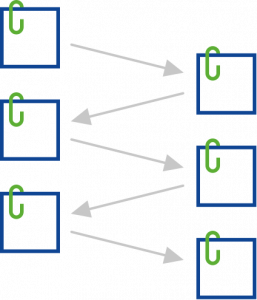
WHAT IS IMPORTANT?
On the second day, we identify the central need for which our design sprint will develop a solution. Therefore, we actively look for problems and prioritise them as well as observed potentials. The aim is to find many different challenges and to select the most suitable problems based on the findings of the previous day. At the end of the day, a central need, which incorporates the most prioritised challenges and potentials is identified for which a solution will be developed. The main goal on this day determines a focus for the ideation phase. The problem we want to solve and the unwanted outcomes have to be identified. We want to create storylines of the current usage. In the end, we will conclude with „How might we…“-statements.
METHODS
Headstand
This method gives us problems instead of solutions. The challenge is formulated oppositely. For example, instead of asking ourselves “which functions do we have to implement to be successful?” we ask ourselves the contrary: “Which function should we not implement?” In other words, how can we manage to fail? We do that because usually recognizing problems is easier than recognizing solutions.
Storytelling
To simplify and better understand the identified problems, we use a method called storytelling. Come together in pairs and draw a story on 6 fields on a piece of paper.
Decision Making
Which of these problems do we want to focus on? We have encountered numerous problems that day. We now have to ask ourselves, which one of the problems is relevant for us and which of them we want to concentrate on. Once again, we reflect on the results accumulated so far. To be clear, this is an important decision that needs to be taken now and for good. If not all participants are on board, you will get stuck discussing this again in the following days. From our experience, jointly formulating the problem statement is a consensus-oriented exercise. It might be enough to simply ask the participants afterwards, if anyone disagrees or has any grievances left. However, be prepared that this can prove more complicated and look for other methods to make decisions in groups. There are a lot of cool ideas already out there.

Problem statement: Lack of legal framework, ignorance and low visibility and availability of reliable information lead to high effort, burden and a low number of implemented projects as well as uncertainty. Experiences and visions are not easily accessible, which hinders the value creation and use of hydrogen.
HOW TO MANAGE YOUR TIME?
15:00 –15:30 Welcoming and reception
15:30 –16:00 Recap of the first day
16:00 –16:45 Headstand
16:45 –17:15 break
17:15 –18:00 Storytelling
18:00 –18:30 Decision making
18:30 –19:00 Closing